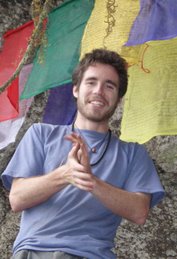Today I submitted a short report regarding my research in Nepal to be published in a forthcoming issue of Himalaya Journal, a publication by the Association for Nepal and Himalayan Studies. It is only about 450 words, so here it is:
The Newars, considered to be the original inhabitants of the Kathmandu Valley, have a long history of contact with the spread of Buddhism. Although Newar culture has been heavily influenced by Hindu social structure, many Newars continue to practice their traditional form of Vajrayana Buddhism. While Tibetans also practice Vajrayana, hundreds of years of isolated development led to the emergence of two very unique Buddhist systems.
There is an opinion amongst many Newar Buddhists that what remains of their highly ritualized system is aberrant and flawed. They point out that although Buddhist doctrine shuns caste discrimination, idealizes the role of celibate monks, and emphasizes personal study and meditation; the Buddhism of the Kathmandu Valley remains bound by a hierarchy of purity, where the tradition of fully ordained monks and nuns is a distant historical memory and the ritual priests are no longer able to expound philosophy and the practical path of meditation to the public. Due to this, Tibetan and Theravadin Buddhism have been embraced by many Newars, displaying a range of attitudes, from the profoundly ecumenical to fiercely competitive.
In the past half-century, many Tibetan lamas have made the Kathmandu Valley their new home. Many local Nepalis, especially Newar Buddhists, found an authentic and open teacher in one such lama, Tulku Orgyen Rinpoche. Tulku Orgyen was a prolific teacher, and his legacy includes a number of highly qualified teachers and monasteries in the Kathmandu Valley. Their connection with Newar Buddhists has continued to develop in a modern context, as both Tibetan and Newari understanding about what it means to be an active Buddhist practitioner evolves. Traditional roles are changing; Newar Buddhist scholars are trained both in the monastery and the modern university context, Newar monks come from farmer and trader castes, rather than just the priestly, and lay Newars take Tantric initiation from Tibetan gurus alongside Nepalis from Hindu backgrounds and Western students.
My research in the Kathmandu Valley aims to record my observations of and discussions with those Newar Buddhists who have accepted Tibetan lamas as their teachers, paying particular attention to new synthesis in Buddhist practice and ritual. The small Newar town of Chapagaon serves as an ideal case study site for my research. A few years ago, a Newar family, who were devotees of Orgyen Tulku Rinpoche, built and offered him a small Tibetan style monastery near the locally important Vajravarahi temple. The Chapagaon monastery's main prayer hall is an important site for local women to hold communal morning prayer (in both Tibetan and Newari), and the monks perform rituals for devoted sponsors. I am also visiting a variety of Newar bahals (traditional Newar Buddhist monasteries) and Tibetan monasteries in the valley that involve community Newars, often times to observe teachings, rituals and prayer.
Friday, January 26, 2007
Subscribe to:
Post Comments (Atom)


3 comments:
Most Newars now don't know enough about Buddhism to assess their own Buddhist traditions. Nor do most Westerners who pronounce on Newar Buddhism.
hi Rechungpa,
hows things going at chapagoen? greeting from your vajra brothers kuala lumpur
Doing well, Ray. Just spent 10 days up at Nagi gompa for a drupchen and retreat, and will be back in Chapagaon this weekend.
n is true on both counts, I.S., and I'll be the first to admit I have a very limited understanding of Newar Buddhism. I have met some Newars, however, who have a good grasp of Buddhism, namely some MS and PHD students of Buddhism/Asian Studies at Tribhuvan University in Kathmandu, like the good folks at the Nagarjuna Institute for Exact Methods (nagarjunainstitute.com). there is a handful of highly learned monks and nuns of the tibetan tradition that are newars here, and they are becoming excellent sources of information.
one of the reasons so many newars are embracing theravada and also tibetan traditions is that there is such little living knowledge about their own practice and philosophical tradition left, especially when compared to highly educated monks and nuns from southeast asia or big named tibetan lamas.
Post a Comment